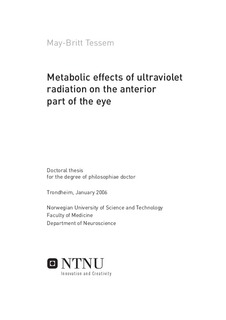| dc.contributor.author | Tessem, May-Britt | nb_NO |
| dc.date.accessioned | 2014-12-19T14:16:47Z | |
| dc.date.available | 2014-12-19T14:16:47Z | |
| dc.date.created | 2006-05-22 | nb_NO |
| dc.date.issued | 2006 | nb_NO |
| dc.identifier | 125957 | nb_NO |
| dc.identifier.isbn | 82-471-7784-6 | nb_NO |
| dc.identifier.uri | http://hdl.handle.net/11250/263151 | |
| dc.description.abstract | Ultraviolet radiation (UV-R) is an environmental factor known to increase the risk of developing an irreversible opacification of the lens (cataract). Increased irradiance of UV-R to the earth because of depletion of stratospheric ozone is of current concern considering cataract formation. Detailed metabolic information from the cornea, lens and aqueous humour might give valuable knowledge on the biochcemical processes occurring in the eye after exposure to UV-R, and thereby a better understanding of the mechanisms by which UV-R induces cataractogenesis. The purpose of this thesis was to study metabolic effects of exposure to UV-R on the anterior part of the eye. Effects of UV-B (280-315 nm) and UV-A (315-400 nm) on the aqueous humour, cornea and the lens from animal models were investigated by 1H nuclear magnetic resonance (NMR) spectroscopy. Since the lens is composed of functionally distinct anatomical compartments, with different metabolic activity, biochemical changes in various compartments of the lens were analyzed.
Application of NMR-based metabonomics was effective to analyze metabolic changes in the anterior part of the eye after exposure to UV-R. High-resolution (HR) magic angle spinning (MAS) 1H NMR spectroscopy provided high quality spectra from intact tissue of cornea and lens, and provided important information about metabolic alteration occurring in these tissues after exposure to UV-R. The results from this thesis show that in vivo UV-B radiation affects metabolism of the anterior compartments of the eye. Metabolic changes were observed in aqueous humour, cornea, lens and in the different compartments of the lens. The antioxidants, glutathione and ascorbate, several amino acids, high energetic phosphates, and compounds important for membrane building and osmoregulation were substantially altered after exposure to UV-B radiation. Several biochemical effects such as oxidation, membrane disruption, osmoregulatory problems, lipid peroxidation, problems with cellular signalling and impairment of growth and protein synthesis were suggested. After UV-A exposure, no observable metabolic alterations were found in the anterior part of the eye in the present animal models. | nb_NO |
| dc.language | eng | nb_NO |
| dc.publisher | Det medisinske fakultet | nb_NO |
| dc.relation.ispartofseries | Doktoravhandlinger ved NTNU, 1503-8181; 2006:22 | nb_NO |
| dc.relation.haspart | Tessem, MB; Bathen, TF; Cejková, J; Midelfart, A. Effect of UV-A and UV-B Irradiation on the Metabolic Profile of Aqueous Humor in Rabbits Analyzed by 1H NMR Spectroscopy. Invest Ophthalmol Vis Sci.. 46: 776-781, 2005. | nb_NO |
| dc.relation.haspart | Tessem, MB; Midelfart, A; Cejková, J; Bathen, TF. Effect of UVA and UVB Irradiation on the Metabolic Profile of Rabbit Cornea and Lens Analysed by HR-MAS 1H NMR Spectroscopy. Ophthalmic Res. 38(2): 105-114, 2006. | nb_NO |
| dc.subject | Ultraviolet rays | en_GB |
| dc.subject | eye injuries | en_GB |
| dc.subject | MEDICINE: Morphology, cell biology, pathology: Cell biology: Neuroscience | en_GB |
| dc.title | Metabolic effects of ultraviolet radiation on the anterior part of the eye | nb_NO |
| dc.type | Doctoral thesis | nb_NO |
| dc.contributor.department | Norges teknisk-naturvitenskapelige universitet, Det medisinske fakultet | nb_NO |
| dc.description.degree | PhD i nevrovitenskap | nb_NO |
| dc.description.degree | PhD in Neuroscience | en_GB |
